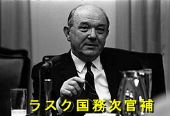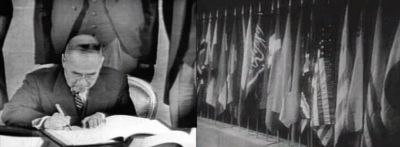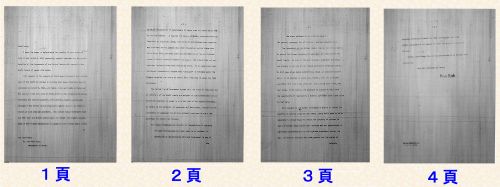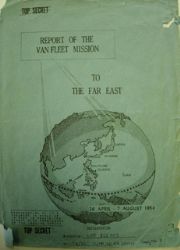| |
|
||||
| 1949年12月29日に連合国(中心は合衆国)が日本との平和条約(サンフランシスコ条約)の草案を作成しました。1951年、その草案への要望書を韓国駐米大使・梁裕燦は合衆国政府に2度に渡り提出しています。韓国政府に対し、当時の米国国務次官補ディーン・ラスクが最終的決定として同年8月10日に通達した文書が『ラスク書簡』です。そして、サンフランシスコ条約の調印がなされたのは、その1ヶ月後にあたる9月8日のことです。 |
 |
|||
| 『ラスク書簡』の存在は1994年に塚本孝氏が論文で紹介していたようですが、文書の画像は2006年にOppekepe7氏がEnjoy-Koreaで公表したもので、米国国会図書館憲政資料室で発見したとのことです。邦訳(塚本孝氏訳)はココにあります。 | ||||
 |
昭和26年(1951年)9月8日 サンフランシスコ講和条約署名 (平和条約) 署名 49ヶ国 |
|||
| 以下に『ラスク書簡』の全文を紹介します。 | ||||
 |
||||
| Excellency: I have the honor to acknowledge the receipt of your notes of July 19 and August 2, 1951 presenting certain requests for the consideration of the Government of the United States with regard to the draft treaty of peace with Japan. |
|||
| 閣下 日本との平和条約の草案について、合衆国政府に考慮を求める閣下からの文書を、1951年の7月19日と8月2日に確かに受領致しました。 |
|||
| With respect to request of the Korean Government that Article 2(a) of the draft be revised to provide that Japan "confirms that it renounced on August 9, 1945, all right, title and claim to Korea and the islands which were part of Korea prior to its annexation by Japan, including the islands Quelpart, Port Hamilton, Dagelet, Dokdo and Parangdo," the United States Government regrets that it is unable to concur in this proposed amendment. The United States Government does not feel that the Treaty should adopt the theory that Japan's acceptance of the Potsdam Declaration on August 9, 1945 constituted a formal or final renunciation of sovereignty by Japan over the areas dealt with in the Declaration. | |||
| 遺憾ながら、草案第2条(a)を「済州島、巨文島、鬱陵島、独島、パラン島を含めて併合前に韓国領であった島々を、日本は1945年8月9日に放棄した」という文言に書き改めるという韓国政府の要求について、合衆国政府は同意できません。合衆国は、日本が1945年8月9日のポツダム宣言受諾で正式あるいは最終的に宣言対象の地域を放棄したとする説を、平和条約に採り入れようとは思いません。 | |||
| As regards the island of Dokdo, otherwise known as Takeshima or Liancourt Rocks, this normally uninhabited rock formation was according to our information never treated as part of Korea and, since about 1905, has been under the jurisdiction of the Oki Islands Branch Office of Shimane Prefecture of Japan. The island does not appear ever before to have been claimed by Korea. It is understood that the Korean Government's request that "Parangdo" be included among the islands named in the treaty as having been renounced by Japan has been withdrawn. | |||
| 竹島、リアンクール岩として知られている『独島』に関しては、我々の情報によれば、日常的には無人の岩礁で、韓国の地域として扱われたことはなく、1905年頃からは日本の島根県隠岐島支所の管轄でした。島はこれまで、韓国から領土主張されたことはありません。本条約で日本が放棄すべき島として韓国政府が要求していた『パラン島』については、取り下げられたものと理解します。 | |||
| The United States Government agrees that the terms of paragraph (a) of Article 4 of the draft treaty are subject to misunderstanding and accordingly proposes, in order to meet the view of the Korean Government, to insert at the beginning of paragraph (a) the phrase, "Subject to the provisions of paragraph (b) of this Article", and then to add a new paragraph (b) reading as follows: | |||
| (b) "Japan recongnizes the validity of dispositions of property of Japan and Japanese nationals made by or pursuant to directives of United States Military Government in any ofthe areas referred to in Articles 2 and 3". | |||
| The present paragraph (b) of Article 4 becomes paragraph(c). | |||
| 合衆国政府は草案4条(a) の文言が誤解を招きやすいことに同意し、従って韓国政府の見解と一致させるために、(a)の冒頭に「本条(b) の規定に従う事を条件として」という句を挿入し、次いで下記の如く新たに(b) を追加することを提案します。 | |||
| (b) 日本国は、第2条および第3条により規定される地域において、合衆国軍政府の指令によってなされた日本国及び日本国民の財産の処分の有効性を認める。 | |||
| 現在の4条(b) は (c)になります。 | |||
| The Government of the United States regrets that it is unable to accept the Korean Government's amendment to Article 9 of the draft treaty. In view of the many national interests involved, any attempt to include in the treaty provisions governing fishing in high seas areas would indefinitely delay the treaty's conclusion. It is desired to point out, however, that the so-called MacArthur line will stand until the treaty comes into force, and that Korea, which obtains the benefits of Article 9, will have the opportunity of negotiating a fishing agreement with Japan prior to that date. | |||
| (連合軍は日韓の漁業境界ラインを暫定的に設けました。マッカーサーラインといいます。『竹島』が韓国側になっていました。このラインをSF条約の中で認めるように、韓国政府は合衆国政府に要求しています。この要求が認められなかった為に、間もなく、韓国は李承晩ラインを設けて日本漁民を銃撃・拿捕するという海賊もどきの蛮行に走ります) | |||
| 合衆国政府は、韓国政府の草案9条の修正案を受け入れることができず残念です。多くの国の利害が関係しますから、公海上の漁業を統制する条項を条約に含めようとすることは、条約締結を無制限に遅らせてしまいます。しかし、いわゆるマッカーサーラインは条約発効までは有効ですから、9条の利益を得る韓国は、(日韓で協議をする時間はありますから)条約発効日までに日本と漁業協定を協議する機会を得られる点は指摘しておきます。 | |||
| With respect to the Korean Government's desire to obtain the benefits of Article 15(a) of the treaty, there would seem to be no necessity to oblige Japan to return the property of persons in Japan of Korean origin since such property was not sequestered or otherwise interfered with by the Japanese Government during the war. In view of the fact that such persons had the status of Japanese nationals it would not seem appropriate that they obtain compensation for damage to their property as a result of the war. | |||
| (条約15条(a)は財産の保障) 条約15条(a) の利益取得について韓国政府の希望に関しては、在日韓国人の財産が、戦時中に日本政府により没収されたりその他妨害されたりしていないことからすれば、日本に当該財産を返還するように義務付ける必要はないものと思われます。そのような人々が日本国民の地位を有していた事実からすれば、戦争の結果としてその者たちの財産への損害補償を得るものとすることは妥当とは思えません。 |
|||
| Accept, Excellency, the renewed assurances of my highest consideration. For the Secretary of State: Dean Rusk |
|||
| ここに重ねて閣下への最高の敬意を表します。 国務長官のために ディーン・ラスク(Dean Rusk) |
|||
|
||||
| 韓国政府は『ラスク書簡』(1951.08.10)を無視して、一方的に独島(=竹島)領有や李承晩ラインの宣言(1952.01.18)をし、日本漁船への銃撃を始めます。朝鮮戦争(1950.06.25〜1953.07.27停戦)の最中です。国連軍としては、壊滅状態の韓国軍を支えて戦局を一変させたものの38度線を境に膠着している状態にあり、内部での足並みの乱れは絶対に避けねばなりません。ある面、韓国らしいやり方でした。 朝鮮戦争休戦後の1954年、ヴァン・フリートは第34代アイゼンハワー米大統領の特使として韓国・日本・台湾・フィリピンなどを訪問し、中国・共産主義勢力に対する韓国を中心とした動向、懸案をまとめた報告書を作成しました。それが、『ヴァン・フリート特命報告書』です。機密文書でしたが、1986年に機密が解除され、現在は一般に公開されています。 ヴァン・フリートは、朝鮮戦争においては国連軍とアメリカ第八軍の司令官として共産軍と戦い、また、韓国軍の精鋭化のために士官教育や軍士官学校の設立などに努めて「韓国軍の父」とも呼ばれており、どちらかと言えば親韓派ですが、李承晩の対日行為には憤然とした姿勢で批判しています。 その骨子は次の通りです。 |
 |
|||
| ● 一方的な領海宣言(李承晩ライン)は違法である | |||
| The United States Government has consistently taken the position that the unilateral proclamation of sovereignty over the seas is illegal and that the fisheries dispute between Japan and Korea should be settled on the basis of a fisheries conservation agreement that would protect the interests of both countries. | |||
| ● 米国政府はサンフランシスコ講和条約において竹島は日本領土であると結論している | |||
| When the Treaty of Peace with Japan was being drafted, the Republic of Korea asserted its claims to Dokto but the United States concluded that they remained under Japanese sovereignty and the Island was not included among the Islands that Japan released from its ownership under the Peace Treaty. | |||
| ● この領土問題は国際司法裁判所を通じて解決されることが望まれる | |||
| Our position has been that the dispute might properly be referred to the International Court of Justice and this suggestion has been informally conveyed to the Republic of Korea. | |||
| 以下に、報告書の日本に関する部分を抜粋して、紹介します。 | |||
| Report of Van Fleet mission to the Far East Report of Van Fleet mission to the Far East, 26 April - 7 August , 1954 by Ambassador James A. Van Fleet |
|||
| ヴァン・フリート特命報告書 1954年 4月26日〜8月7日 特使 ジェームス・ヴァン・フリート |
|||
| A. Japan 1. Fisheries Of the several problems at issue between Japan and Korea, the fisheries problem is by far the most important, not only because it is of vital concern to the Japanese (a nation that lives on fish) but because the Republic of Korea Government has taken overt action against Japanese fishermen apprehended fishing in the Sea of Japan (or Eastern Sea, as the Koreans call it) approximately 60 miles from Korean shores. The Japanese have eagerly sought a settlement with the Republic of Korea. As for the Koreans, they are genuinely concerned over the possible depletion of their fisheries resources by the superior Japanese fishing fleet. This is particularly acute for the Koreans because they do not have adequate vessels and equipment and trained personnel to fish in waters that are not closely adjacent of Korea. This problem involves the enforcement of the so-called "Rhee Line" or "Peace Line" in the Eastern Sea. |
|||
| A. 日本 1. 漁業 日本と韓国の幾つかの問題の1つである漁業問題は、最重要問題である。それは日本人の生命線(国民は魚を食べて生活している)だけでなく、韓国政府が沿岸から凡そ60マイルにある日本海(韓国名は東海)で漁をしている日本漁民を拿捕するという行動を取っているのである。日本人は韓国との合意点を真剣に求めている。韓国人は、日本の優れた漁船により水産資源が枯渇することを本当に心配している。韓国人には、沖合での漁業に適用した装備、漁船、訓練された人材がなく、これに特に敏感である。この問題は、東部の海(日本海)における李ライン若しくは平和線の執行により発生している。 |
|||
|
The essential facts are that the Republic of Korea Government has unilaterally proclaimed its sovereignty over a large area of the high seas bordering Korea and by the use of the Republic of Korea Navy has attempted to exclude Japanese fishermen from operations within the area. At times, the Republic of Korea Navy has fired upon Japanese vessels; some of the vessels have been apprehended and taken to Korean ports. After the crews have been tried and sentenced, most of the captured fishermen have been released, but the vessels usually have been detained and are now being reportedly operated by the Republic of Korea. It is believed that the Japanese Government is willing to enter into a reasonable fisheries conservation agreement that would guarantee the preservation of the fisheries and restrict Japanese operation in the area. |
|||
| 極めて重要なことは、韓国政府が広大な海域の主権を一方的に宣言し、公海において、韓国海軍が当該領域での日本漁師の操業を排除したことである。時には、韓国海軍が日本漁船に発砲し、拿捕し韓国の港に連行している。乗組員は裁判にかけられ、処罰を受けた後に、大半が保釈されているが、漁船は抑留され現在、韓国によって運用されているとの報告がある。日本政府は、日本の操業を制限し、漁業資源の確保を保証する合理的な漁業協定を望んでいる。 | |||
|
According to President Rhee, the "Peace Line" serves a three-fold purpose: |
|||
| 李大統領によれば、李ラインは3つの目的を有している。 a. 韓国沿岸水域の貴重な海洋資源の保護 b. 漁業資源の韓国と日本におけるの将来の摩擦の排除 c. 共産党員の浸透に対する海域での防御 |
|||
|
The position of the Republic of Korea Government has been to insist on the recognition of the so-called "Peace Line." The United States Government has consistently taken the position that the unilateral proclamation of sovereignty over the seas is illegal and that the fisheries dispute between Japan and Korea should be settled on the basis of a fisheries conservation agreement that would protect the interests of both countries. The chronology and other aspects of the fisheries is discussed in more detail in Enclosure No. 1. |
|||
| 韓国政府の意向は、所謂「平和線」の承認を前提とした主張である。合衆国政府は一貫して、海洋の主権に関する一方的な宣言が違法であり、日韓間の漁業に関する紛争が両国の権益を保護する漁業協定によって解決されるべきとの立場である。年表と漁業に関しては、別添No.1でより詳細に議論する。 | |||
| 4. Ownership of Dokto Island The Island of Dokto (otherwise called Liancourt and Take Shima) is in the Sea of Japan approximately midway between Korea and Honshu (131.80E, 36.20N). This Island is, in fact, only a group of barren, uninhabited rocks. When the Treaty of Peace with Japan was being drafted, the Republic of Korea asserted its claims to Dokto but the United States concluded that they remained under Japanese sovereignty and the Island was not included among the Islands that Japan released from its ownership under the Peace Treaty. The Republic of Korea has been confidentially informed of the United States position regarding the islands but our position has not been made public. Though the United States considers that the islands are Japanese territory, we have declined to interfere in the dispute. Our position has been that the dispute might properly be referred to the International Court of Justice and this suggestion has been informally conveyed to the Republic of Korea. |
|||
| 4. 獨島の領有権 獨島(別名:リアンクールロック、竹島)は、日本海の日本の本州と韓国のほぼ中間地点にある(東経131°80” 北緯36°20”)。この島は、実際、不毛な無人の岩である。日本との平和条約が起草された時、韓国は獨島の権利を主張したが、合衆国は日本の主権の下に残すことを決定し、平和条約の日本が所有権を放棄する島々には含めなかった。韓国は合衆国の獨島に関する意向を内々に知っていたが、合衆国はその意向を公表しなかった。合衆国は獨島を日本の領土であると考えるが、紛争への介入は拒否した。紛争を国際司法裁判所に適切に付託すべきであるという我々の意向は非公式に韓国に伝えられた。 |
|||
|
The Mission was advised by Republic of Korea that:
|
|||
| 韓国の意見 「悪いことに、日本は、ダジュレー島として知られる鬱陵島の近くにある小さな島である、リアンクールロックとして知られる獨島の領有を未だに主張している。日本の公職者は武装した船舶に乗ってたびたび島を訪れ、韓国漁民を悩ましている。彼らは島の至る所に、獨島が日本の領土であるかのように記した標識を設置している。我々の歴史と知識では、海洋主権宣言(李ライン)の瞬間にまさに帰結している。韓国の獨島の主権は決して他国に争われたことなく、獨島が歴史的と同時に法的に鬱陵島(ダジュレー島)の一部として韓国領土であるという事実を長期に渡り確固たるものとして確立したのである」 |
|||